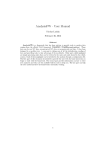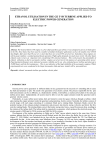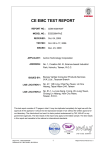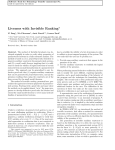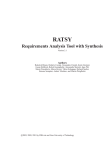Download Automated Composition of Nondeterministic and Partially
Transcript
Automated Composition of
Nondeterministic and Partially
Observable Stateful Services
Riccardo De Masellis and Francesco Fusco
December 9, 2008
1
Abstract
In this paper we study the issue of service composition, in the case that services
are nondetermistic and partially observable (POTS). In particular, the target
service is represented as a finite deterministic transition system, whereas available services are described as finite, nondeterministic and partially observable
transition systems. Our aim is, in the first place, to expose a methodology to
transform a POTS in a different, but fully observable TS, named KTS, then
we show a particular polinomial encoding of this problem in SMV, that allows
to solve the problem of composition using the known techinque of reducing the
synthesis to the search a safety game winning strategy.
2
Introduction
A finite and potentially nondeterministic transition system is a tuple T S =
hA, S, s0 , δ, F i where:
• A is the finite set of action;
• S is the finite set of states;
• s0 is the initial state;
• δ ⊆ S × A × S is the transition relation;
• F is the set of final states.
A finite, potentially nondeterministic and partially observable transition system
differs from the previous one in the presence of an observability function. More
formally, is a tuple P OT S = hA, S, s0 , δ, F, σi where:
1
• σ : S → C is a function that returns the observation of a state. We
don’t care about the codomain C, it may be whatever, e.g. the set of
natural numbers N or a set of propositional variables that represent some
information of the given state. If this function is injective, we say that the
TS is fully observable.
The partial observability raises no problems if the TS is deterministic, i.e. if
∀s1 , s2 , s3 ∈ S, a ∈ A (δ(s1 , a, s2 ) ∧ δ(s1 , a, s3 ) → s2 = s3 ). In this case, the
transition relation is, in fact, a function δ : S × A → S, and even if all states
have the same observation, we can know any moment in which state the TS is,
simply by storing actions performed. To the contrary, when we have to deal
with a nondeterministic and partially observable TS, we may don’t know the
future state after a transition. Here we show a methodology to transform a
POTS in a fully observable TS. This formalization is based on the idea that
in a sequence of action calls to the comunity services, not only we can use the
observation of a state, but also the actions sequence itself (previously stored for
the purpose) to understand in which state the TS actually is.
3
KTS
The new TS, is a tuple KT S = hAk , K, k0 , δk , Fk i built in this way:
• The set K is built inductively as follows:
– s0 ∈ K;
– ~s ∈ K ∧ (~s, a, s~0 ) ∈ δk → s~0 ∈ K.
• The transition relation δk is built as follows:
∀~s ∈ 2S , ∀a ∈ A we define:
(
img(~s, a) =
Ø
if (∃s ∈ ~s | (s, a, ∗) ∈
/ δ)
0
0
{s ∈ S | ∃s ∈ ~s ∧ (s, a, s ) ∈ δ} otherwise
obs(~s) = {o | ∃s ∈ ~s ∧ σ(s) = o}
Then, (~s, a, s~0 ) ∈ δk if and only if:
s~0 6= Ø ∧ s~0 = {s ∈ img(~s, a) | ∃o ∈ obs(img(~s, a)) ∧ σ(s) = o∧
∧∀s0 , s00 ∈ s~0 → σ(s0 ) = σ(s00 )}
• The finite set of actions Ak is composed by all actions contained in δk ;
• k0 = s0 ;
• Fk = {s ∈ F ∩ K} ∪ {~s ∈ K | ∀si ∈ ~s → si ∈ F };
2
d
b
c
s4
s1
a
c
a
c
s0
a
s2
b
s5
a
σ2
σ1
d
d
s3
σ0
Figure 1: Example of POTS.
Note that, by constuction: ∀~s ∈ K → |obs(~s)| = 1 and, by consequence, every ~s
such that obs(~s) 6= 1 cannot be reached by any transition.
In other words, the new KTS’ states, are, in effect, macrostates, that represent our incomplete knowledge after a nondeterministic transition which arrival
states have the same observation. Theoretically, everyone of 2S states could
be in the set K and every 2s · A · 2s transition could be in the set δk , so the
procedure works as follows: it first calculates every possible transition relations
that could be in δk , and then builds inductively the set of states K.
In Figure 1 is shown a POTS, and in fig.2, the corresponding KTS, build
with the methodology described above.
From a computational point of view, this metodology is exponential in the
number of POTS’ states. This exponential cost cannot be avoided, because in
the worst case the cardinality of KTS’ macrostates is exactly 2S , as shown in
Figure 3 and Figure 4. In this example, transition relations of the associated
KTS are not complete, but what is important is that the number of states is
exponential in the cardinality of POTS’ states.
Once we convert a POTS into a KTS, that is in fact, a standard nondeterministic TS, we can use one of the known nondeterministic services composition
tecniques. But this solution is unacceptable for at least two reason: (i) building
a KTS as presented above is very inefficient, because its cost is exponential even
in the best case; (ii) conversions are made in any case, even if the converted
3
d
c
c
s1
b
{s1,s2}
{s4,s5}
a
b
b
c
s0
s5
s2
b
a
c
{s0,s3}
d
Figure 2: KTS corresponding to the POTS of Figure 1
c, e, f
start_op
s2
σ1
c, f
start_st
b, d
b, d
c, e
start_op
a, d, e
b, f
s0
a, e
start_op
s1
b, d, f
σ0
Figure 3: Example of worst case transformation: POTS.
4
s2
s1
{s1,s2}
c
b
start_st
f
start_op
{s1,s2, s3}
a
e
d
s0
{s0,s2}
{s0,s1}
Figure 4: Example of worst case transformation: KTS (not complete).
TSs will never be called. For this reasons, we tried a different approach: an
on-line algorithm, that makes the conversion step-by-step, only if the service is
selected, that is to say, only if it is necessary. This algorithm is based on the
idea that, during the composition, the only informations we need to know are:
(i) the actual state of the TSs, i.e. if they are in a final, initial, or any other
state; (ii) if they are able to perform a certain action. The algorithm is an
extension of a pre-existing framework used to synthesizing compositions, that
use the TLV system [1], it will be illustrated in Section 5, because first we need
to introduce the reason why we can use TLV for computing compositions. Since
in paper [1] is used the word operation instead of action, from now on we will
use these two words as synonyms.
4
Composition via Safety Games
In this Section, we show how a service composition problem instance can be
encoded into a game automaton. The main motivation behind this approach
is the increasing availability of software systems, such as TLV, which provide
(i) efficient procedures for strategy computation, (ii) convenient languages for
representing the problem instance in a modular, intuitive and pretty straightforward way and (iii) efficent data structures for representig boolean functions.
5
4.1
Safety Game structure
Throughout the rest of the paper, we assume to deal with infinite-run TSs,
possibly obtained by introducing fake loops, as customary in LTL verification/synthesis.
Starting from [8], we define a safety-game structure (or -game structure or
-GS, for short) as a tuple G = hX , V, Y, Θ, ρe , ρs , ϕi, where:
• V = {v1 , . . . , vn } is a finite set of state variables, ranging over finite domains V1, . . . , Vn, respectively. We assume that each state s =hx, yi
i.e., a complete assignment of values to variables. Let V be the set of all
possible valuations for the variables in V;
• X ⊆ V is the set of environment variables. Let X be the set of all possible
valuations for variables in X , x ⊆ X is called environment state;
• Y = V \ X is the set of system variables. Let Y be the set of all possible
valuations for variables in Y, y ⊆ Y is called a system state;
• Θ is a formula representing the initial states of the game. It is a boolean
combination of expressions (vk = v¯k ) where vk ∈ V and v¯k ∈ Vk (k ∈
{1, . . . , n}) (partial assignments are allowed). For such formulae, given a
state hx, yi ∈ V , we write hx, yi |= Θ if state s satisfies the assignments
specified by Θ;
• ρe (X , Y, X 0 ) is the environment transition relation which relates a current
(unprimed) game state to a possible next (primed) environment state;
• ρs (X , Y, X 0 , Y 0 ) is the system transition relation, which relates a game
state plus a next environment state to a next system state;
• ϕ is a formula that represents the invariant property to be guaranteed.
In particular, ϕ has the same form as Θ.
A game state hx0 , y 0 i is a successor of hx, yi iff ρe (x, y, x0 ) and ρs (x, y, x0 , y 0 ). A
play of G is a maximal sequence of states η : hx0 , y0 i hx1 , y1 i . . . satisfying (i)
hx0 , y0 i |= Θ, and (ii) for each j ≥ 0, hxj+1 , yj+1 i is a successor of hxj , yj i.
Given a -GS G, in a given state hx, yi of a game play, the environment
chooses an assignment x0 ∈ X such that ρe (x, y, x0 ) holds and the system chooses
assignment y 0 ∈ Y such that ρs (x, y, x0 , y 0 ) holds. A play is said to be winning
for the system if it is infinite and satisfies the winning condition ϕ. Otherwise,
it is winning for the environment. A strategy for the system is a partial function
f : (X × Y )+ × X → Y such that for every λ : hx0 , y0 i . . . hxn , yn i and for
every x0 ∈ X such that ρe (xn , yn , x0 ), ρs (xn , yn , x0 , f (λ, x0 )) holds. A play η :
hx0 , y0 i , hx1 , y1 i . . . is said to be compliant with a strategy f iff for all i ≥ 0,
f (hx0 , y0 i . . . hxi , yi i , xi+1 ) = yi+1 . A strategy f is winning for the system from
a given state hx, yi iff all plays starting from hx, yi and compliant with f are
so. When such a strategy exists, hx, yi is said to be a winning state for the
6
Algorithm 1 WIN. Computes system’s maximal set of winning states in a
-GS
1: W := {hx, yi ∈ V | hx, yi |= ϕ}
2: repeat
3:
W 0 := W ;
4:
W := W ∩ π(W );
5: until (W 0 = W )
6: return W
system. A -GS is said to be winning for the system if all initial states are so.
Otherwise, it is said to be winning for the environment.
Our objective is to encode a composition problem into a -GS, compute the
maximal set of states that are winning for the system, and from this, directly
computing the orchestrator. Let us show how such winning set can be computed
in general on a -GS. The core of the algorithm is the following operator:
Definition 1 Let G = hX , V, Y, Θ, ρe , ρs , ϕi be a -GS as above. Given a set
P ⊆ V of a game states hx, yi the set of P’s controllable predecessor is:
.
π(P ) = {hx, yi ∈ V | ∀x0 .ρe (x, y, x0 ) → ∃y 0 .ρs (x, y, x0 , y 0 ) ∧ hx0 , y 0 i ∈ P }
Intuitively, π(P ) is the set of states from which the system can force the
play to reach a state in P, no matter how the environment evolves. Based on
this, Algorithm 1 computes the set of all system’s winning states of a -GS
G = hX , V, Y, Θ, ρe , ρs , ϕi as Thoerem 1 shows.
Theorem 1 Let G = hX , V, Y, Θ, ρe , ρs , ϕi be a -GS as above and W be
obtained as in Algorithm 1. Given a state hx̄, ȳi ∈ V , a system’s winning strategy
f starting from hx̄, ȳi exists iff hx̄, ȳi ∈ W .
In fact, one can define a system’s winnig strategy f (hx0 , y0 i , . . . , hxi , yi i , x) =
y, by picking up, for each x such that ρe (xi , yi , x) holds, any hx, yi ∈ W .
4.2
From composition problem to safety games
Before giving technical details about the reduction from composition problem
instances to -GS, let us introduce our approach from a high-level perspective.
Recall that the service composition problem consists in finding a orchestrator
able to coordinate a community in a way such that the obtained system can
always satisfy the requests of a client compliant with a given deterministic target service. First, note that given the target service, all and only legal client
behaviors can be obtained by executing the target service in every possible way.
Second, observe that the target service is a virtual entity whose operations are
to be actually executed by one available service, subject to its current state and
capabilities. Therefore, target service and community can be soundly thought
to evolve synchronously, the former issuing requests for operations, i.e. acting as a client, and the latter satisfying them, i.e. actually implementing the
7
target service. In addition, observe that community services are mutually asynchronous, i.e., exactly one moves at each step. Finally, we can isolate the only
part that needs to be synthesized, i.e., the orchestrator. It is an automaton
which, synchronously with both the target service and the community, outputs
an identifier to delegate one available service to execute the operation currently
requested.
In order to encode the composition problem as a safety-game structure, we
need first to individuate which place each component, e.g. target and available services, will occupy in the game representation. The above remarks are
intended for this purpose. Conceptually, our goal is to refine an uncostrained
orchestrator, that is, an automaton capable of selecting, at each step, one among
all the available services, in a way such that the community is always able to
satisfy target service requests. This suggests immediately to represent the orchestrator as the system in the game structure, that is the entity we want to
synthesize a winning strategy for. Consequently, and coherently with above observations, community services and target service, will be properly combined and
encoded as environment. Finally, the winning condition needs to be defined. We
remark that the goal of system’s strategies is to guarantee the winning condition
holds throughout all possible plays induced by the strategy itself, starting from
an initial state. The winning condition will be formally encoded as conjunction
of the following high-level properties:
• (game’s) initial state is winning by default;
• if target service is in a final state, all community services do, as well;
• the servie selected by the orchestrator is able to perform the action currently requested by the target service.
Now, let C = hS1 , . . . , Sn i be a community, where Si = hAi , Si , si0 , Fi , δi , σi i
(i = 1, . . . , n) and St = hAt , St , st0 , Ft , δi i a target service. We assume, without
loss of generality, that every service of the comunity was a POTS, because a TS
is simply a POTS with an injective observability function. From C and St we
derive a -GS G = hX , V, Y, Θ, ρe , ρs , ϕi as follows:
• V = {st , s~1 , . . . , s~n , a, ind}, where:
–
–
–
–
st ∈ St ∪ {init};
s~i ∈ 2Si ∪ {init} (i = 1, . . . , n);
a ∈ At ∪ {init};
ind ∈ {1, . . . , n} ∪ {init};
with an intuitive semantics: each complete valutation of V represents: (i)
the current state of the target service and community (variables st , s~1 , . . . , s~n );
(ii) the operation to be performed next, that belongs to the set of action
of the target service; (iii) the available service selected to perform it (variable ind ). Special value init has been introduced for convenience, so as to
have fixed initial state.
8
• X = {st , s~1 , . . . , s~n , a} is the set of environment variables;
• Y = {ind} is the (singleton) set of system variables;
• Θ = (st = init) ∧ (
V
si
i=0,...,n (~
= init)) ∧ (a = init) ∧ (ind = init);
• ρe (X , Y, X 0 ) is defined as follows:
– hhinit, . . . , initi , init, hst , ~s1 , . . . , ~sn , aii ∈ ρe iff st = st0 , ~si = ~si0 for
i = (1, . . . , n) and there exists a transition hst0 , a, stj i ∈ δt for some
j ∈ {0, . . . , |St |};
– if st 6=
init, s~i 6= init with i
= (1, . . . , n), a 6=init and ind 6= init,
then hst , s~1 , . . . , s~n , ai , ind, s0t , s~1 0 , . . . , s~n 0 , a0 ∈ ρe iff the followings hold in conjunction:
1. there exists a transition hst , a, s0t i ∈ δt ;
2. Recall Section 3, if we suppose to have associated KTSs to all
POTSs of the community, either there exists a transition h~sind , a, ~s0ind i ∈
δk ind or ~sind = ~s0ind i.e., service wrongly makes no move and the
error violates the safety condition ϕ, see below;
3. s~i = s~i 0 for all i = 1, . . . , n such that i 6= ind;
4. there exist a transition hs0t , a, s00t i ∈ δt for some s00t ∈ St .
– hhinit, . . . , initi , init, hst , ~s1 , . . . , ~sn , ai , ind0 i ∈ ρs iff ind0 ∈ {1, . . . , n};
– Formula ϕ is defined depending on the current state, operation and
service selection, as:
n
n
^
^
.
f inali ))
ϕ = Θ ∨ (( ¬f aili ) ∧ (f inalt →
i=1
i=1
where:
V
.
∗ f aili = (ind = i) ∧ ( h~s,op,~s0 i∈δk i (op 6= a ∨ s~i 6= ~s)),encodes the
fact that service i has been selected but, in tis current state, no
transition can take place which executes the requested operation;
.
.
∗ f inali = ∀s ∈ s~i → s ∈ Fi , for i = (1, . . . , n) and f inalt =
∨s∈Ft (st = s), encodes the fact that the service its currently in
one of its final states.
Once we have computed the set W, and encoded our composition problem in a
-GS, synthesizing an orchestrator becomes an easy task. There is a well-defined
procedure, that given the set W and a -GS, builds a finite state program that
returns, at each point, the set of available behaviours capable of performing a
target-conformant operation. We call such a program orchestrator generator, or
simply PG. Formally:
9
Theorem 2 Let C = hS1 , . . . , Sn i be a community and St a target service,
where, as usual, St = hAt , St , st0 , Ft δi i and Si = hAi , Si , si0 , Fi , δi , σi i for i =
(1, . . . , n). From C and St we derive a -GS G = hX , V, Y, Θ, ρe , ρs , ϕi
as shown above. Let W be the system’s winning set for G computed as in
Algorithm 1. If hinit, . . . , initi ∈ W then the orchestrator generator P G =
hAt , {1, . . . , n}, Σ, ∂, ωi of C for St , can be built from W as follows:
• At is the usual set of operations;
• {1, . . . , n} is the set of available services’ indexes;
• Σ ∈ 2S1 ×· · ·×2Sn ×St is the set of states of PG, such that hs~1 , . . . , s~n , st i ∈
Σ iff there exists a game state hs~1 , . . . , s~n , st , a, indi ∈ W for some a ∈ At
and ind ∈ {1, . . . , n};
• ∂
transition relation, such that
∈ (Σ × At × {1, . . . ,
n}0 × Σ) is0 the
∈ ∂ iff hs~1 , . . . , s~n , st , a, ki ∈ W
hs~1 , . . . , s~n , st i , a, k, s~1 , . . . , s~n , s0t
0
0
and
there
exists
a
∈
A
and
k
∈
{1,
.
.
.
, n}
such that
t
hs~1 , . . . , s~n , st , a, ki , s~1 0 , . . . , s~n 0 , s0t , a0 , k 0 ∈ ρs ;
• ω : Σ×At → 2{1,...,n} is defined as ω(hs~1 , . . . , s~n , st i , a) = {i ∈ {1, . . . , n} |
hs~1 , . . . , s~n , st , a, ii ∈ W }.
Intuitively, PG is a finite state transducer, that, given an operation a (compliant with the target service), outputs, through ω, the set of all available
services able to perform a next, according to the -GS and W. The role of PG
is very simple. In fact, given a current state hs~1 , . . . , s~n , st i and an operation
a ∈ At to be executed, a service selection s “good” (i.e the selected service can
actually execute the operation and the whole community can still simulate the
target service) if and only if W contains a tuple hs~1 , . . . , s~n , st , a, indi for some
ind ∈ {1, . . . , n}. Consequently, at each step, on the basis of the current state st
of the target service, the state hs~1 , . . . , s~n i of the community and the operation
a, one can select a tuple from W, extract the ind component, and use it for next
service selection.
5
Using TLV for computing compositions
In Section 4 is shown that the synthesis of a composition can be reduced to
the search for a system’s winning set and strategy in a safety-game structure.
In order to solve such problems, we use TLV, that is a software for verification
and synthesis of general LTL specifications, based on symbolic manipulation
of states, through Binary Decision Diagrams (BDDs). It takes two inputs: a
synthesis procedure, encoded in TLV-BASIC, and a LTL specification, encoded
in SMV, to be manipulated by this procedure. In particular, we refer to a
TLV-BASIC pre-existing procedure for safety games (aggiungere pubblicazione)
which takes as input an LTL specification supposed to encode a safety-game
structure and returns, if any, the system’s maximal winning set. The purpose of
10
this section is to show a methodology for producing, starting from an abstract
description of a composition problem, the SMV code that the procedure can take
as input, to automatically generate, if any, the system’s winning set. Here we
describe only the metodology for describing a POTS in SMV, all other modules
are identical to the ones described in [1].
5.1
The SMV encoding
The encoding presented in [1] is composed by several MODULEs:
• System module represents the uncostrained orchestrator, which, apart from
initialization, at each step outputs an index representing the service that
has to perform the actual operation;
• Environment module represents the abstract environment. As described in
[1], when a composition problem is reformulated as a safety-game structure, the environment state is composed of: (i) the state of each available
service; (ii) the state of the target service; and (iii) the operation to
be performed next. State transitions are subject to the following rules.
The target service’s component moves to the (only) successor obtained
by performing the requested operation in the current state, as prescribed
by target service’s transition function, whereas all available service’s components but one, i.e., the selected one, move by looping in their current
state, not failing; the selected one may either generate a failure and loop
in its current state (requested operation operation cannot be performed
by selected service) or correctly move according to its transition relation.
Finally, the operation changes to one of those the target service can perform in its successor state. Summing up, in the game formulation, all
components synchronously move at each step, even though some of them
are forced to loop. It is important to remark this fact because, in our
encoding, the environment is built up from several modules which are
supposed, by smv semantics, to move synchronously. Recall that available
services’ modules are defined so that they loop on the current state both
when they are not selected and when they are but the service they refer
to is not able to perform the requested action in current state. In the
latter case, however, the expression failure becomes true. This perfectly
reflects the semantics associated to the environment when formulating a
composition problem as a safety-game structure. The aim of the module
Env is to combine all modules defined so far and to define when the goal
property g is violated (and the purpose of the synthesis is to build up a
orchestrator such that this never happens). In order to achieve this aim,
the DEFINE section of the environment is build as follows:
DEFINE
initial := s1.initial & s2.initial & ...
& sn.initial & target.initial & operation=start_op;
11
failure := (s1.failure | s2.failure | ... | sn.failure) |
(target.final & !(s1.final & s2.final & ... & sn.final));
These definitions state that: (i) the environment is in the initial state if
all services that belong to the community and the target service are in
their initial states, and the operation is the fictitious initial start_op; (ii)
the environment failure, i.e. the composition fails, if anyone of the services
fails or the traget service is in a final state but there is at least one service
that is not.
• Main module puts toghether the environment and the system to build the
game and defines the g forumula as follows:
DEFINE
good := (sys.initial & env.initial) | !(env.failure);
with immediate understanding. The synthesis algorithm interprets: (i)
the first declared module as environment; (ii) the second one as system;
and (iii) the expression good as the invariant property to be guaranteed
by the synthesized orchestrator.
• Target module desribes in the SMV’s usual way the TS that represents
the service that we want to synthesize. At every iteration, it outputs the
operation that has to be performed.
• Community service module. Every service of the community is represented
as a module that takes as input two parameters: the index generated by
the system module and the operation that has to be performed. Every
service has a different index, so, at every iteration and for every service
s, if the index corresponds to s, then either it performs the operation as
descibed in its TRANS section or it fails, otherwise it loops in its current
state. If the service is a standard nondeterministic TS, then the smv
encoding is trivial. If it is a POTS, the encoding has to be extended
to “implement”, in a some way, an algorithm that verifies whether the
operation can be performed or not.
5.1.1
SMV encoding of a POTS
As anticipated above, the main idea that suggested this encoding is that we don’t
need to have knowledge of the full observable associated KTS. In fact, we don’t
even need to build an associate KTS. The only information we require at every
iteration is the current macrostate in which the selected service actually is. From
the current macrostate, and, obviously, from the description of the POTS, we
can derive all other information we need, for instance, if the service can perform
the operation, or every future macrostate the service could reach by performing
the operation. This encoding is made up in two main part: the first is a trivial
description of the original POTS, the latter is the algorithm itself, that taking
12
d
s1
c
a
d
start_op
start_st
s0
σ2
a
c
σ0
s2
σ1
Figure 5: Example of simple POTS.
into account the actual macrostate, the operation, and the description of the
POTS, computes, if it doesn’t fail, all possible arrival macrostates by performing
the operation, and then “moves” nondeterministically in one of these.
We analyze the encoding in detail by the means of example in Figure 5.
As shown before, every POTS is a module of the smv file, and takes two
inputs, an index and an operation:
MODULE kts1(index, op)
In the VAR section, we define two variables: the first represents the current
macrostate and the latter is choice, its meaning will be explained later on. As
we have to deal with macrostate, i.e. set of states, we have decided to represent
a set in smv by his characteristic function, (cfcurr_macrostate : SP OT S → {0, 1})
so, the variable curr_macrostate is an array of boolean values of length number
of POTS’ states. The i-th entry is setted to 1 if and only if the i-th state belongs
to current macrostate.
VAR
curr_macrostate :
choice :
array 0..3 of {0, 1}; --0=s0, 1=s1,
--2=s2, 3=start_st.
{0, 1, 2};
In the DEFINE section, we store all informations about the POTS (with
the exception of the set A, that is not the POTS’ set of actions, but the set
13
of operations that the Target Service can perform) i.e. the tuple P OT S =
hA, S, s0 , δ, F, σi, using once more characteristic functions. More precisely, with
reference to the example of Figure 5, the initial state (cfinitial_state : SP OT S →
{0, 1}) is an array of POTS’ number of sates, and only the state that refers to
start_st is setted to true:
DEFINE
POTS_initial_state[0]
POTS_initial_state[1]
POTS_initial_state[2]
POTS_initial_state[3]
:=
:=
:=
:=
0;
0;
0;
1;
Analogously, for the final states (cff inal_states : SP OT S → {0, 1}). In our
example, only s0 is a final state:
POTS_final_states[0]
POTS_final_states[1]
POTS_final_states[2]
POTS_final_states[3]
:=
:=
:=
:=
1;
0;
0;
0;
Since we ecode also transition relations with his characteristic function (cftransitions :
SP OT S × AT arget × SP OT S → {0, 1}), we need |SP OT S |· |AT arget | ·| SP OT S | definitions:
POTS_trans[0][0][0]
POTS_trans[0][0][1]
POTS_trans[0][0][2]
POTS_trans[0][0][3]
...
POTS_trans[3][4][3]
:=
:=
:=
:=
0; -- Second index (operation):
1; -- 0=a, 1=b, 2=c, 3=d, 4=start_op.
1;
0;
:= 0;
The first four lines mean that in the state s0 by performing action a, i.e.
action 0, the next POTS’ state could be nondeterministically either s1 or s2 . Is
important to remark that we use numbers to identify operations, because since
op is an input parameter, we can use it, in certain cases, as an arrays index.
Informations about observability function is encoded in the usual way by
the characteristic function (cfobservations : C(σ) × SP OT S → {0, 1}), so we need
|C(σ)| · |SP OT S | definitions:
POTS_oss[0][0]
POTS_oss[0][1]
POTS_oss[0][2]
POTS_oss[0][3]
...
POTS_oss[2][3]
:=
:=
:=
:=
1; -- First index:
0; -- 0=sigma0, 1=sigma1, 2=sigma2.
0;
0;
:= 1;
14
By convention, we use a new observability value for the fictitious state
start_st.
Here ends the description of the POTS, now we define some variables that
are necessary for the algorithm.
As shown before we need to know if it is possible to perform an operation in
a certain state. In a macrostate s is possible to perform an operation a if and
only if in all states that belongs to s it is possible to perform a. So we define:
op_possible :=
(curr_macrostate[0]->
(POTS_trans[0][op][0] | POTS_trans[0][op][1] |
POTS_trans[0][op][2] | POTS_trans[0][op][3])) &
(curr_macrostate[1]->
(POTS_trans[1][op][0] | POTS_trans[1][op][1] |
POTS_trans[1][op][2] | POTS_trans[1][op][3])) &
(curr_macrostate[2]->
(POTS_trans[2][op][0] | POTS_trans[2][op][1] |
POTS_trans[2][op][2] | POTS_trans[2][op][3])) &
(curr_macrostate[3]->
(POTS_trans[3][op][0] | POTS_trans[3][op][1] |
POTS_trans[3][op][2] | POTS_trans[3][op][3]));
It is imporant to notice that, since we have only informations on POTS’
transitions, to know if it is possible to perform an operation op, we have to check,
for every s, if there is at least one state s0 such that P OT S_trans[s][op][s0 ] = 1.
The most important part of the algorithm is how to compute the possible
arrival states. Suppose that the TS was in a generic macrostate, then, if the
operation is possible, we have to know all possible arrival states, grouped by
observations, and then the next macrostate will be formed nondeterministically
among all states that belongs to one of the observations. An example is shown
in Figure 6.
We compute possible arrival states in this way: for every observation o,
and for every state s, s is a possible arrival state if the operation is possible
in the current macrostate ~s and there is at least one state s0 ∈ ~s such that
(s0 , op, s) ∈ δP OT S .
imm_oss[0][0] :=
op_possible &
POTS_oss[0][0] &
( (curr_macrostate[0]
(curr_macrostate[1] &
(curr_macrostate[2] &
(curr_macrostate[3] &
...
imm_oss[2][3] := ...
& POTS_trans[0][op][0]) |
POTS_trans[1][op][0]) |
POTS_trans[2][op][0]) |
POTS_trans[3][op][0]) );
15
s2
s1
a
σ2
a
s3
σ1
s0
a
a
a
s4
σ0
(a) Nondeterministic POTS’ transition. S0 is the initial state.
s1
{s2s3}
a
a
s0
{s0s4}
a
(b) Associated KTS. Notice that the "new" transition
is nondeterministic, and arrival states are grouped by
observations.
Figure 6: Example of nondeterminitic transition.
16
So we define |C(σ)| · |SP OT S | number of variables which, at every iterations,
represent possible arrival states’ characteristic function (cfimm_oss : C(σ) ×
SP OT S → {0, 1}).
As anticipated above, we have to know if the current macrostate is inital or
final. A TS is in an initial state if the input operation is equal to start_op,
input index is equal to 0, and for the (only) state s that belongs to the current
macrostate ~s holds s = s0 .
initial :=
op=4 &
index=0 &
(curr_macrostate[0]->POTS_initial_state[0]) &
(curr_macrostate[1]->POTS_initial_state[1]) &
(curr_macrostate[2]->POTS_initial_state[2]) &
(curr_macrostate[3]->POTS_initial_state[3]);
A macrostate is final if all states that belongs to that macrostate are final.
final :=
(curr_macrostate[0]->POTS_final_states[0]) &
(curr_macrostate[1]->POTS_final_states[1]) &
(curr_macrostate[2]->POTS_final_states[2]) &
(curr_macrostate[3]->POTS_final_states[3]);
The DEFINE section ends with the definition of failure, i.e. the condition
that has not to be veirfied in order for the goal propery g to hold. A TS fails
if it is selected by the System, i.e. the orchestrator, but it cannot perform the
requested operation.
failure :=
index=1 & !(op_possible);
The INIT module is trivial, we only initialize the current macrostate with
start_st and the choice with an arbitrary value.
INIT
curr_macrostate[0]=0
curr_macrostate[1]=0
curr_macrostate[2]=0
curr_macrostate[3]=1
choice=2
&
&
&
&
In the TRANS section, if the service is selected, it moves nonderministically
in one of the imm_oss, otherwise, it loops in its current macrostate. This
can be done by choosing nondeterministically an integer, the variable choice
that has as many values as the number of obervations, and then update the
current macrostate with the states of respective, nondeterministically chosen
observation. It is important to notice that we have to be careful that the arrival
imm_oss was not empty.
17
TRANS
case (index=0 | index=1) :
next(choice) in {0, 1, 2}
&
( next(choice)=0 ->
( next(curr_macrostate[0])=imm_oss[0][0] &
next(curr_macrostate[1])=imm_oss[0][1] &
next(curr_macrostate[2])=imm_oss[0][2] &
next(curr_macrostate[3])=imm_oss[0][3] &
( next(curr_macrostate[0]) | next(curr_macrostate[1]) |
next(curr_macrostate[2]) | next(curr_macrostate[3])) ) )
&
( next(choice)=1 ->
( next(curr_macrostate[0])=imm_oss[1][0] &
next(curr_macrostate[1])=imm_oss[1][1] &
next(curr_macrostate[2])=imm_oss[1][2] &
next(curr_macrostate[3])=imm_oss[1][3] &
( next(curr_macrostate[0]) | next(curr_macrostate[1]) |
next(curr_macrostate[2]) | next(curr_macrostate[3])) ) )
&
( next(choice)=2 ->
( next(curr_macrostate[0])=imm_oss[2][0] &
next(curr_macrostate[1])=imm_oss[2][1] &
next(curr_macrostate[2])=imm_oss[2][2] &
next(curr_macrostate[3])=imm_oss[2][3] &
( next(curr_macrostate[0]) | next(curr_macrostate[1]) |
next(curr_macrostate[2]) | next(curr_macrostate[3]) ) ) );
!(index=1 | index=0) :
next(curr_macrostate[0])=curr_macrostate[0]
next(curr_macrostate[1])=curr_macrostate[1]
next(curr_macrostate[2])=curr_macrostate[2]
next(curr_macrostate[3])=curr_macrostate[3]
next(choice)=choice;
&
&
&
&
The variable choice is necessary, because as we have to update a set of state,
if we had encoded:
next(curr_macrostate[0]) in
{imm_oss[0][0], imm_oss[1][0], imm_oss[2][0]} &
next(curr_macrostate[1]) in
{imm_oss[0][1], imm_oss[1][1], imm_oss[2][1]} &
...
then we would obtained:
next(curr_macrostate[0])=imm_oss[0][0] &
18
Figure 7: Truth table and decision tree representations of a Boolean function.
A dashed (solid) branch denotes the case where the decision variable is 0(1).
next(curr_macrostate[1])=imm_oss[2][1] &
...
It is important to underline that, even if this algorithm is intrinsically exponential, this encoding is polinomial w.r.t. the input, so the exponential cost is
paied only if it necessary, and in any case is handled by TLV.
6
TLV and Ordered Binary Decision Diagrams
The key idea of OBDDs is that by restricting the representation, boolean manipulation becomes much simpler computationally. Consequently, they provide
a suitable data structure for a symbolic boolean manipulator.
6.1
Introduction to BDDs
A binary decision diagram represents a boolean function as a rooted, directed
acyclic graph. As an example, Figure 7 illustrates a representation of the function f (x1 , x2 , x3 ) defined by the truth table given on the left, for the special
case where the graph is actually a tree. Each nonterminal vertex v is labeled
by a variable var(u) and has arcs directed toward two children: lo(v) (shown
as a dashed line) corresponding to the case where the variable is assigned 0
and hi(v) (shown as a solid line) corresponding to the case where the variable
is assigned 1. Each terminal vertex is labeled 0 or 1. For a given assignment
to the variables, the value yielded by the function is determined by tracing a
path from the root to a terminal vertex, following the branches indicated by
the values assigned to the variables. The function value is then given by the
terminal vertex label. Due to the way the branches are ordered in this figure,
the values of the terminal vertices, read from left to right, match those in the
truth table, read from top to bottom.
For an Ordered BDD (OBDD), we impose a total ordering < over the set of
variables and require that for any vertex u, and either nonterminal child v, their
19
respective variables must be ordered var(u) < var(v). In the decision tree of
Figure 7, for example, the variables are ordered x1 < x2 < x3 . In principle, the
variable ordering can be selected arbitrarily, the algorithms will operate correctly
for any ordering. In practice, selecting a satisfactory ordering is critical for the
efficient symbolic manipulation. We define three transformation rules over these
graphs that do not alter the function represented:
• Remove Duplicate Terminals. Eliminate all but one terminal vertex
with a given label and redirect all arcs into the eliminated vertices to the
remaining one.
• Remove Duplicate Nonterminals. If nonterminal vertices u and v
have var(u) = var(v), lo(u) = lo(u), and hi(u) = hi(v), then eliminate
one of the two vertices and redirect all incoming arcs to the other vertex.
• Remove Redundant Tests. If nonterminal vertex v has lo(u) = hi(u),
then eliminate u and redirect all incoming arcs to lo(v).
Starting with any BDD satisfying the ordering property, we can reduce its size
by repeatedly applying the transformation rules. We use the term “OBDD” to
refer to a maximally reduced graph that obeys some ordering. For example,
Figure 8 illustrates the reduction of the decision tree shown in Figure 7 to an
OBDD. Applying the first transformation rule (a) reduces the eight terminal
vertices to two. Applying the second transformation rule (b) eliminates two of
the vertices having variable x3 and arcs to terminal vertices with labels 0 (lo)
and 1 (hi ). Applying the third transformation rule (c) eliminates two vertices:
one with variable x3 and one with variable x2 . In general, the transformation
rules must be applied repeatedly, since each transformation can expose new possibilities for further ones. The OBDD representation of a function is canonical,
for a given ordering, two OBDDs for a function are isomorphic. This property
has several important consequences. Functional equivalence can be easily tested.
A function is satisfiable iff its OBDD representation does not correspond to the
single terminal vertex labeled 0. Any tautological function must have the terminal vertex labeled 1 as its OBDD representation. If a function is independent of
variable x, then its OBDD representation cannot contain any vertices labeled by
x. Thus, once OBDD representations of functions have been generated, many
functional properties become easily testable. As figg.7 and 8 illustrate, we can
construct the OBDD representation of a function given its truth table by constructing and reducing a decision tree. This approach is practical, however, only
for functions of a small number of variables, since both the truth table and the
decision tree have size exponential in the number of variables. Instead, OBDDs
are generally constructed by “symbolically evaluating” a logic expression or logic
gate network using the APPLY operation described in the next section.
6.2
Construction of OBDDs
A number of symbolic operations on boolean functions can be implemented as
graph algorithms applied to the OBDDs. These algorithms obey an important
20
(a) Duplicate terminals
(b) Duplicate nonterminals
(c) Redundant tests
Figure 8: Reduction of decision tree to OBDD. Applying the three reduction
rules to the tree of Figure 7 yields the canonical representation of the function
as an OBDD.
closure property: given that the arguments are OBDDs obeying some ordering,
the result will be an OBDD obeying the same ordering. Thus we can implement
a complex manipulation with a sequence of simpler manipulations, always operating on OBDDs under a common ordering. Users can view a library of BDD
manipulation routines as an implementation of a boolean function abstract data
type, except for the selection of a variable ordering, all of the operations are
implemented in a purely mechanical way. The user needs not to be concerned
with the details of the representation or the implementation.
6.2.1
The APPLY operator
The APPLY operation generates boolean functions by applying algebraic operations to other functions. Given argument functions f and g, plus binary boolean
operator hopi, (e.g., AND or OR) APPLY returns the function f hopi g. This
operation is central to a symbolic boolean manipulator. With it we can complement a function f by computing f ⊕ 1. Given functions f and g, and “don’t
care” conditions expressed by the function d (i.e., d(~x) yields 1 for those variable assignments ~x for which the function values are unimportant), we can test
¯ +d
whether f and g are equivalent for all “care” conditions by computing (f ⊕g)
and test whether the result is the function 1. The APPLY algorithm operates by traversing the argument graphs depth first, while maintaining two hash
tables: one to improve the efficiency of the computation and one to assist in
producing a maximally reduced graph. Note that whereas earlier presentations
treated the reduction to canonical form as a separate step [Bryant 1986], the
following algorithm produces a reduced form directly. To illustrate this operation, we will use the example of applying the + operation to the functions
f (a, b, c, d) = (a + b) · c + d and g(a, b, c, d) = (a · c̄) + d, having the OBDD
representations shown in Figure 9(a).
The implementation of the APPLY operation relies on the fact that algebraic
21
(a) Example arguments to APPLY operation.
Vertices are labeled for identification during the
execution trace.
(b) Execution trace for APPLY
operation with operation +. Each
evaluation step has as operands a
vertex from each argument graph.
Figure 9: Example of APPLY operation.
operations “commute” with the Shannon expansion for any variable x :
f hopi g = x · (f |x←1 hopi g |x←1 ) + x̄ · (f |x←o hopi g |x←o )
This equation forms the basis of a recursive procedure for computing the
OBDD representation of f hopi g. For our example, the recursive evaluation
structure is illustrated in Figure 9(b). Note that each evaluation step is identified
by a vertex from each of the argument graphs. Suppose functions f and g
are represented by OBDDs with root vertices rf and rg , respectively. For the
case where both rf and rg are terminal vertices, the recursion terminates by
returning an appropriately labeled terminal vertex. In our example, this occurs
for the evaluations A4 , B3 and A5 , B4 . Otherwise, let variable x be the splitting
variable, defined as the minimum of variables var(rf ) and var(rg ). OBDDs
for the functions f |x←1 hopi g |x←1 and f |x←o hopi g |x←o , are computed by
recursively evaluating the restrictions of f and g for value 1 (indicated in 9(b) by
solid lines) and for value 0 (indicated by the dashed lines). For our example, the
initial evaluation with vertices A1 , B1 causes recursive evaluations with vertices
A2 , B2 and A6 , B5 .
6.3
Transitions represented as OBDDs
Classic algorithms that analize finite-state system construct an explicit representation of the state graph and then analyze its path and cycle structure [Clarke
et al. 1986]. These techniques become impractical, however, as the number of
states grows large. Unfortunately, even relatively small digital systems can have
very large state spaces. More recently, researchers have developed “symbolic”
state graph methods, in which the state transition structure is represented as
a boolean function [Burch et al. 1990a; Coudert et al. 1990]. This involves
22
(a) Explicit representation of nondeterministic
finite-state machine. The size of the representation grows linearly with the number of states.
(b) Symbolic representation of nondeterministic finite-state machine.
The number of variables grows logarithmically with the number of
states.
Figure 10: Explicit and symbolic representation of nondeterministic finite-state
machine.
first selecting binary encodings of the system states and input alphabet. The
next-state behavior is described as a relation given by a characteristic function δ(~x, ~o, ~n) yielding 1 when input ~x can cause a transition from state ~o to
state ~n. As an example, Figure 10(a) illustrates an OBDD representation of the
nondeterministic automaton having the state graph illustrated in Figure 10(a).
This example represents the three possible states using two binary values by
the encoding σ(A) = [0, 0], σ(B) = [1, 0], and σ(C) = [0, 1]. Observe that the
unused code value [1, 1] can be treated as a “don’t care” value for the arguments
~o and ~n in the function δ. In the OBDD of Figure 10(b), this combination is
treated as an alternate code for state C to simplify the OBDD representation.
For such a small automaton, the OBDD representation does not improve on
the explicit representation. For more complex systems, on the other hand, the
OBDD representation can be considerably smaller. McMillan [1992] has characterized some conditions under which the OBDD representing the transition
relation for a system grows only linearly with the number of system components, whereas the number of states grows exponentially. In particular, this
property holds when both (i) the system components are connected in a linear
or tree-structure and (ii) each component maintains only a bounded amount
of information about the state of the other components. This bound holds for
ringconnected systems, as well, since a ring can be “flattened” into a linear chain
of bidirectional links. Given the OBDD representation, properties of a finitestate system can be expressed then by fixed-point equations over the transition
23
function, and these equations can be solved using iterative methods, similar to
those described to compute the transitive closure of a relation. For example,
consider the task of determining the set of states reachable from an initial state
having binary coding ~q by some sequence of transitions. Define the relation S to
indicate the conditions under which for some input ~x, there can be a transition
from state ~o to state ~n. This relation has a characteristic function:
χS (~o, ~n) = ∃~x[δ(~x, ~o, ~n)].
χS (~o, ~n) = ∃~x[δ(~x, ~o, ~n)]. Then set of states reachable from state ~q has characteristic function:
χR (~s) = χS (~q, ~s).
Unfortunately, the system characteristics that guarantee an efficient OBDD representation of the transition relation do not provide useful upper bounds on the
results generated by symbolic state machine analysis. For example, we can
devise a system having a linear interconnection structure for which the characteristic function of the set of reachable states requires an exponentially sized
OBDD [McMillan 1992]. On the other hand, researchers have shown that a
number of real-life systems can be analyzed by these methods.
6.4
How TLV uses OBDDs
TLV reads programs written in SMV or in SPL, translates them to OBDDs, and
then enters an interactive mode where OBDDs can be manipulated. The interactive mode includes a high level programming language, called TLV-BASIC
which also understand SMV expressions. The TLV system is constructed on the
top of the CMU SMV system.
TLV uses Boolean Decision Diagrams (BDDs) to represent functions, transitions and state valutations.
The present version of the program has no built-in heuristics for selecting
variable ordering. Instead, variable appear in the BDDs in the same order in
which they are declared in the program. This means that variables declared
in the same module are grouped together, which is generally a good practice,
but this alone is not generally sufficient to obtain good performance in the
evaluation.
Usually the variable ordering must be adjusted by hand, in an ad hoc way.
A good heuristic is to arrange the ordering so that variables which often appear
close to each other in formulas are close together in the order of declaration, and
global variables should appear first in the program. The number of BDD nodes
currently in use is printed on standard error each time the program performs
garbage collection, if verbose level is greater than zero. An important number
to look at is the number of BDD nodes representing the transition relation. It
is very important to minimize this number.
TLV uses a simple automatic variable reordering algorithm (adopted from
smv2.4.4) which can be used if you do not want to bother to reorder the variables
by hand. It goes over all variables of the program, tries to put each variable in
24
all possible positions and nds the position which minimizes the total number of
bdd nodes. The variable is then moved to that location.
7
Implementation
In this section we will walk through the implementation process of Automatic
Composition of Partially Observable Services. Before getting in depth into the
actual implementation process, we will make clear the supposed input and the
output products of this phase together with the assumptions we made along the
development process.
7.1
Input-output
The inputs to the system are Transition Systems describing the behavior of the
services belonging to the community and of the target service, plus some further
information concerning community properties (see section 7.2). As was made
clear before a Service behavior can be completely specified through a Transition
System. The informations we need from a TS are:
• the service name;
• the service states;
• the service actions;
• the service initial state;
• the service final states;
• the service transition function;
• the service observation function (in the case the service was partially observable).
In order to make simpler, for the user, to give these TSs as an input, we made
possible for the system to accept a XML representation of these TSs. To be
more precise, the representation we chose is not a strict XML file. As the
information we needed, could be expressed in really simple way we did not
specify a proper XML schema, but we just introduced the language tags we
needed for our purpose. An example of a TS in its XML format, is the following:
<service>
<name>kts1</name>
<actions>
<action>0</action>
...
25
</actions>
<states>
<state>s0</state>
...
<state>start_st</state>
</states>
<initial_state>
<state>s0</state>
</initial_state>
<final_states>
<state>s0</state>
</final_states>
<trans_funct>
<trans>
<state>s0</state>
<action>0</action>
<state>s1</state>
</trans>
...
<trans>
<state>start_st</state>
<action>4</action>
<state>s0</state>
</trans>
</trans_funct>
<obs_funct>
<obs>
<state>s0</state>
<obs_value>0</obs_value>
</obs>
...
<obs>
<state>start_st</state>
<obs_value>2</obs_value>
</obs>
</obs_funct>
</service>
The output of the system is a .smv file, which can be directly executed by
the TLV engine. This file contains all the modules needed to check whether the
26
composition, for the specific target service, exists in the community, or not.
7.2
Assumptions
The assumptions we made in the project are mainly about two aspects: the
information contained in the XML files, and the information we need about
some properties of the community.
The first assumption we made about the XML TS specification is about the
names that can be used to define the states, the actions and the service names.
The names that can be used for the states are character strings of the form X-kwhere X is a single character, and -k- is an integer number.
The names that can be used for the actions are of the form k where k is an
integer number.
The service names that should be used are target for the target service, and:
kts-k- for the community services, where -k- is an integer number.
Another assumption is that the XML files describing the TSs contain a special state called start_st and a special action start_op representing, respectively,
the service starting state and the service starting operation. Of course on the
observation function section of the XML, there must be the observation value
associated to start_st. This is a sort of normalization we have to make among
the community services. It’s needed because of the particular model that was
adopted to check for the composition existence [Pnueli 2006]. So we kept this
normalization for the sake of consistency with that model.
Concerning the community properties, we assume that the user explicitly
specifies, the number of services in the community, the number of distinct actions
the services in the community can perform, and the that the user provides an
unique identifier (an integer) to each service in the community.
7.3
The framework
The programming language we used for this project is java, this was because
of the previous knowledge we had of this language, but the choice of any other
high level programming language would have been absolutely equivalent.
The actual implementation of the Automatic Composition of Partially Observable Services system is made up, mainly, of two java classes, which provide,
the methods needed to generate a directly executable .smv file. There’s a class,
which provides the utilities needed to read and parse the XML files, and another
one that provides the utilities needed to generate the .smv files itself. These two
classes are actually utilities classes provided with mainly static methods.
The supposed way to use the framework we implemented by defining a java
Client class, which calls the methods of the above utilities classes in order to
actually generate the .smv output file. In this Client class the user needs to
specify the file system paths we the XML resources are located, the file system
path where he wants the output to be saved, plus the community properties we
mentioned in the section 7.2.
27
We won’t go in depth into the APIs we provided in our framework, because
these can be easily found in the javadoc documentation that comes along with
framework itself.
7.4
Problems
The main problems we had to face during the implementation process are related
to the mismatch that exists between the representations we have of the TSs and
the data structures used in the SMV language. The natural interpretation of
the information contained in the XML file, representing a TS, is a “list” of
properties. For instance, if we consider the transition function, in the XML, it’s
encoded as a list of triples of the form:
<trans>
<state>starting_state</state>
<action>action</action>
<state>arrival_state</state>
</trans>
In the SMV files, instead, we needed to encode this function in a slightly
different way, because, what we needed was a characteristic function. For example, the above transition would be encoded as:
service_trans_funct[starting_state][action][arrival_state] = true;
that meaning: the transition that, starting from starting_state, performing
the action action, leads to arrival_state, belongs to the transition function.
Moreover when we had to define the TRANS section in the Target service
MODULE, we had to add, to the information provided by the transition function, the information about the action the service could perform, once arrived
in the arrival_state. In order to do this we had to explicitly extract this information from the transition function, and this needed the use of some auxiliary
data structures.
We had some problems also because, as we needed to use integer numbers
as pointers to elements in data structures, we choose for the use of arrays, but
due to the static length of these data structures, we had to pay much attention
on the usage of those.
8
A simple example
Here we show a simple example of how our algorithm and implementation works.
In this example the target service is represented in Figure 11 and the community
is composed by two services shown in Figure 12. It is not hard to see that the
target service can be sinthesized.
To start our program just launch the class Client, and the graphic interface
(Figure 13) suggests to: (i) insert the number of service of the community; (ii)
28
d
t1
c
a
b
start_op
start_st
t0
t2
c
Figure 11: Target service.
insert the number of actions; (iii) browse the HD to search for the .xml files
that describe the behaviour of target and community services; (vi) click on the
“Save .smv file” to select a location for the .smv that is automatically generated.
After that we use the just generated .smv file as input to the TLV procedure
for checking the existence of a composition. The output is the following:
Mac-Mas:~/Studio/Seminari_Ing_SW/tlv-src-4.18.4 De_Mas$
./tlv comp-inv.pf /Users/De_Mas/Desktop/tesina_ver2.0/composition2.smv
TLV version 4.18.4
System #1:
System #2:
System #3:
Resources used:
user time: 0.01 s
BDD nodes allocated: 1959
max amount of BDD nodes allocated: 1959
Bytes allocated: 327744
Loading Util.tlv $Revision: 4.3 $
Loading MCTL.tlv $Revision: 4.3 $
Loading MCTLS.tlv $Revision: 4.1 $
Loading TESTER.tlv $Revision: 4.2 $
Loading MCsimple.tlv $Revision: 4.2 $
Loading SIMULATE $Revision: 4.2 $
Loading Floyd.tlv $Revision: 4.1 $
Loading Abstract.tlv $Revision: 4.2 $
Loading deductive.tlv $Revision: 4.2 $
29
d
s1
c
a
d
start_op
start_st
s0
σ2
a
s2
c
σ0
σ1
(a) kts1
d
s1
c
b
c
b
start_op
start_st
s0
s2
σ2
c
σ0
(b) kts2
Figure 12: Community services
30
Figure 13: The Java program’s graphic interface.
Loaded rules file Rules.tlv.
Check Realizability
Specification is realizable
Check that a symbolic strategy is correct
Transition relation is complete
All winning states satisfy invariant
Automaton States
State 1
env.operation = 4, env.target.state = start_st,
env.s1.curr_macrostate[0] = 0, env.s1.curr_macrostate[1]
env.s1.curr_macrostate[2] = 0, env.s1.curr_macrostate[3]
env.s1.choice = 1,
env.s2.curr_macrostate[0] = 0, env.s2.curr_macrostate[1]
env.s2.curr_macrostate[2] = 0, env.s2.curr_macrostate[3]
env.s2.choice = 1,
sys.index = 0,
State 2
env.operation = 0, env.target.state = t0,
31
= 0,
= 1,
= 0,
= 1,
env.s1.curr_macrostate[0]
env.s1.curr_macrostate[2]
env.s1.choice = 0,
env.s2.curr_macrostate[0]
env.s2.curr_macrostate[2]
env.s2.choice = 0,
sys.index = 1,
= 1, env.s1.curr_macrostate[1] = 0,
= 0, env.s1.curr_macrostate[3] = 0,
= 1, env.s2.curr_macrostate[1] = 0,
= 0, env.s2.curr_macrostate[3] = 0,
State 3
env.operation = 1, env.target.state = t0,
env.s1.curr_macrostate[0] = 1, env.s1.curr_macrostate[1]
env.s1.curr_macrostate[2] = 0, env.s1.curr_macrostate[3]
env.s1.choice = 0,
env.s2.curr_macrostate[0] = 1, env.s2.curr_macrostate[1]
env.s2.curr_macrostate[2] = 0, env.s2.curr_macrostate[3]
env.s2.choice = 0,
sys.index = 2,
State 4
env.operation = 2, env.target.state = t2,
env.s1.curr_macrostate[0] = 1, env.s1.curr_macrostate[1]
env.s1.curr_macrostate[2] = 0, env.s1.curr_macrostate[3]
env.s1.choice = 0,
env.s2.curr_macrostate[0] = 0, env.s2.curr_macrostate[1]
env.s2.curr_macrostate[2] = 1, env.s2.curr_macrostate[3]
env.s2.choice = 0,
sys.index = 2,
State 5
env.operation = 2, env.target.state = t1,
env.s1.curr_macrostate[0] = 0, env.s1.curr_macrostate[1]
env.s1.curr_macrostate[2] = 1, env.s1.curr_macrostate[3]
env.s1.choice = 1,
env.s2.curr_macrostate[0] = 1, env.s2.curr_macrostate[1]
env.s2.curr_macrostate[2] = 0, env.s2.curr_macrostate[3]
env.s2.choice = 0,
sys.index = 1,
State 6
env.operation = 3, env.target.state = t1,
env.s1.curr_macrostate[0] = 0, env.s1.curr_macrostate[1]
env.s1.curr_macrostate[2] = 1, env.s1.curr_macrostate[3]
env.s1.choice = 1,
env.s2.curr_macrostate[0] = 1, env.s2.curr_macrostate[1]
env.s2.curr_macrostate[2] = 0, env.s2.curr_macrostate[3]
env.s2.choice = 0,
32
= 0,
= 0,
= 0,
= 0,
= 0,
= 0,
= 1,
= 0,
= 1,
= 0,
= 0,
= 0,
= 1,
= 0,
= 0,
= 0,
sys.index = 1,
State 7
env.operation = 2, env.target.state = t1,
env.s1.curr_macrostate[0] = 0, env.s1.curr_macrostate[1]
env.s1.curr_macrostate[2] = 0, env.s1.curr_macrostate[3]
env.s1.choice = 1,
env.s2.curr_macrostate[0] = 1, env.s2.curr_macrostate[1]
env.s2.curr_macrostate[2] = 0, env.s2.curr_macrostate[3]
env.s2.choice = 0,
sys.index = 1,
State 8
env.operation = 3, env.target.state = t1,
env.s1.curr_macrostate[0] = 0, env.s1.curr_macrostate[1]
env.s1.curr_macrostate[2] = 0, env.s1.curr_macrostate[3]
env.s1.choice = 1,
env.s2.curr_macrostate[0] = 1, env.s2.curr_macrostate[1]
env.s2.curr_macrostate[2] = 0, env.s2.curr_macrostate[3]
env.s2.choice = 0,
sys.index = 1,
= 1,
= 0,
= 0,
= 0,
= 1,
= 0,
= 0,
= 0,
Automaton Transitions
From
From
From
From
From
From
From
From
1
2
3
4
5
6
7
8
to
to
to
to
to
to
to
to
2
5
4
2
2
7
2
7
3
6
3
3
8
3
8
Automaton has 8 states, and 15 transitions
For an easy reading, in Figure 14 is show the output of the computation,
the automaton, i.e. the orchestrator generator.
8.1
Counterexample
In order to test our algorithm, here we show a counterexample. To make the
composition of the previous example not realizable, we just modify a transition
in the kts1. More precisely, instead of hs2 , c, s0 i ∈ δkts1 , we replace hs2 , c, s2 i. It
is not hard to see that now, if the target service perform the action c while it
is in the state t1 , it goes in a final state, t0 , whereas the service kts1 remains in
a not final state, s2 , and that violates the invariant property good. The output
33
s5
op=2
target_st=t1
s1.curr_macr=[0,1,1,0]
s2.curr_macr=[1,0,0,0]
index=1
s1.choice=1
s2.choice=0
s2
op=0
target_st=t0
s1.curr_macr=[1,0,0,0]
s2.curr_macr=[1,0,0,0]
index=1
s1.choice=0
s2.choice=0
s3
s8
op=3
target_st=t1
s1.curr_macr=[0,1,0,0]
s2.curr_macr=[1,0,0,0]
index=1
s1.choice=1
s2.choice=0
op=1
target_st=t0
s1.curr_macr=[1,0,0,0]
s2.curr_macr=[1,0,0,0]
index=2
s1.choice=0
s2.choice=0
s6
op=3
target_st=t1
s1.curr_macr=[0,1,1,0]
s2.curr_macr=[1,0,0,0]
index=1
s1.choice=1
s2.choice=0
s7
op=2
target_st=t1
s1.curr_macr=[0,1,0,0]
s2.curr_macr=[1,0,0,0]
index=1
s1.choice=1
s2.choice=0
34
s1
op=4
target_st=start_st
s1.curr_macr=[0,0,0,1]
s2.curr_macr=[0,0,0,1]
index=0
s1.choice=1
s2.choice=1
s4
op=2
target_st=t2
s1.curr_macr=[1,0,0,0]
s2.curr_macr=[0,1,1,0]
index=2
s1.choice=0
s2.choice=0
Figure 14: Orchestrator Generator.
of TLV engine, is, in fact:
Check Realizability
Specification is unrealizable
9
Limitations and future work
Concerning to the SMV encoding, even if the encoding is not exponential, but
polinomial, some parts, for instance the part of the algorithm that computes
the imm_oss[][], have still a complexity of O(n2 ) where n = |S|, even in the
best case. It is possible that some refinement could optimize this bound.
Concering to the JAVA implementation, most of the limitations of our system
are about the assumptions we make when we take the information as an input.
Most of these could be overcome by removing these assumptions we mentioned
before. That is to say, for instance, allowing for the automatic insertion of the
start_st and the start_op, into the TSs representation.; allowing the user to
choose arbitrary names for the states and for the actions; and allowing the user
to describe the TSs via a GUI, without the need of actually write the TS XML
file. Another nice thing to implement, would be a graphical visualization of
the output composition if it exits. We also know that, with a better structured
design phase, some of the limitations we underlined above would have been clear
before, and so, maybe, also solved before. But, even if, of course, our approach
has some obvious limitations, these are just implementation limitations, i.e.,
they are not restrictive, by any mean, on the theoretical results we showed
above. All of the issues we have, can in fact, be solved with ease, and the only
reason why, we didn’t provide solutions to these issues here, is only for a lack
of time.
References
[1] G. De Giacomo and F. Patrizi. Automated Composition of Nondeterministic
Stateful Services. Technical report, 2008.
[2] D. Berardi, F. Cheikh, G. De Giacomo and F. Patrizi. Automated Service
Composition Via Simulation. Int. J. Found. Comput. Sci. 19(2): 429-451
(2008).
[3] F. Patrizi. Using TLV as a Planning Tool for Non-deterministic or Againstenemies Domains. Technical report.
[4] R.
E.
Bryant.
Symbolic
Boolean
Manipulation
with
Ordered
Binary-Decision
Diagrams.
http://portal.acm.org/ft_gateway.cfm?id=136043&type=pdf&coll=GUIDE&dl=GUIDE
&CFID=14039920&CFTOKEN=36747860, Sept. 1992.
35
[5] E. Shahar. The TLV Manual. http://www.wisdom.weizmann.ac.il/~amir/Course02a/tlvmanual.ps,
Dec. 2002.
[6] R. Cavada, A. Cimatti, C. A. Jochim, G. Keighren, E. Olivetti,
M. Pistore, M. Roveri and Andrei Tchaltsev. NuSMV User Manual.
http://nusmv.fbk.eu/NuSMV/userman/v24/nusmv.pdf, 2005.
[7] F. Patrizi. Simulation-based Techniques for Automated Service Composition. Technical report.
[8] N. Piterman, A. Pnueli, and Y. Sa’ar. Synthesis of reactive(1) designs. In
VMCAI, pages 364–380, 2006.
36




































